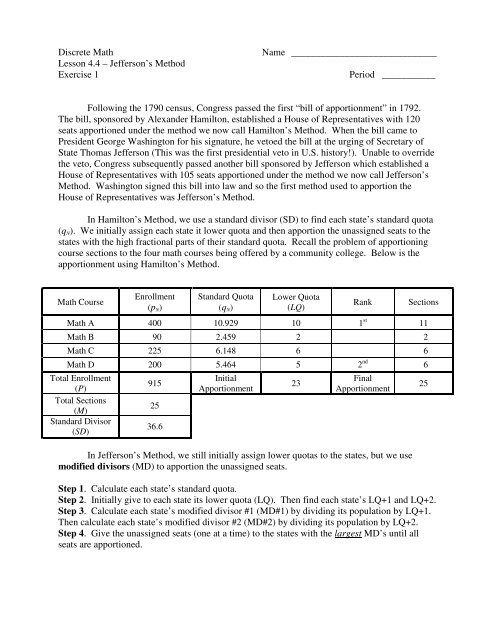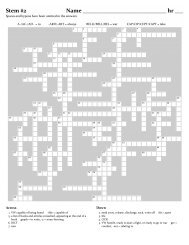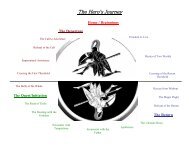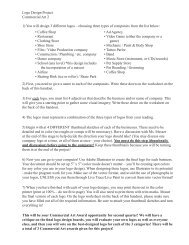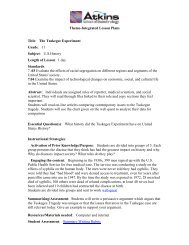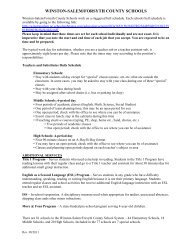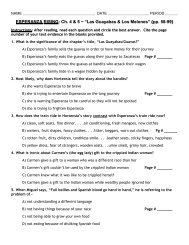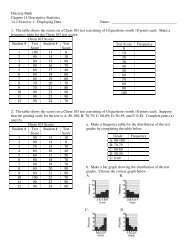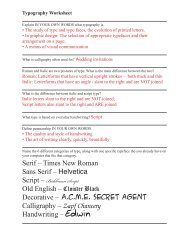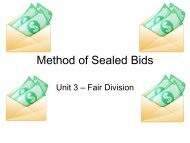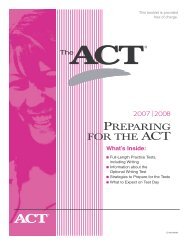Lesson 4.4 – Jefferson's Method Exercise 1 Period ______ Follow
Lesson 4.4 – Jefferson's Method Exercise 1 Period ______ Follow
Lesson 4.4 – Jefferson's Method Exercise 1 Period ______ Follow
You also want an ePaper? Increase the reach of your titles
YUMPU automatically turns print PDFs into web optimized ePapers that Google loves.
Discrete Math<strong>Lesson</strong> <strong>4.4</strong> – Jefferson’s <strong>Method</strong><strong>Exercise</strong> 1Name ______________________________<strong>Period</strong> ___________<strong>Follow</strong>ing the 1790 census, Congress passed the first “bill of apportionment” in 1792.The bill, sponsored by Alexander Hamilton, established a House of Representatives with 120seats apportioned under the method we now call Hamilton’s <strong>Method</strong>. When the bill came toPresident George Washington for his signature, he vetoed the bill at the urging of Secretary ofState Thomas Jefferson (This was the first presidential veto in U.S. history!). Unable to overridethe veto, Congress subsequently passed another bill sponsored by Jefferson which established aHouse of Representatives with 105 seats apportioned under the method we now call Jefferson’s<strong>Method</strong>. Washington signed this bill into law and so the first method used to apportion theHouse of Representatives was Jefferson’s <strong>Method</strong>.In Hamilton’s <strong>Method</strong>, we use a standard divisor (SD) to find each state’s standard quota(q N ). We initially assign each state it lower quota and then apportion the unassigned seats to thestates with the high fractional parts of their standard quota. Recall the problem of apportioningcourse sections to the four math courses being offered by a community college. Below is theapportionment using Hamilton’s <strong>Method</strong>.Math CourseEnrollment(p N )Standard Quota(q N )Lower Quota(LQ)In Jefferson’s <strong>Method</strong>, we still initially assign lower quotas to the states, but we usemodified divisors (MD) to apportion the unassigned seats.Step 1. Calculate each state’s standard quota.Step 2. Initially give to each state its lower quota (LQ). Then find each state’s LQ+1 and LQ+2.Step 3. Calculate each state’s modified divisor #1 (MD#1) by dividing its population by LQ+1.Then calculate each state’s modified divisor #2 (MD#2) by dividing its population by LQ+2.Step 4. Give the unassigned seats (one at a time) to the states with the largest MD’s until allseats are apportioned.RankSectionsMath A 400 10.929 10 1 st 11Math B 90 2.459 2 2Math C 225 6.148 6 6Math D 200 5.464 5 2 nd 6Total Enrollment(P)Total Sections(M)Standard Divisor(SD)9152536.6InitialApportionment23FinalApportionment25
Example 1: Complete the table below to determine the apportionment of course sections to themath courses using Jefferson’s <strong>Method</strong>.Math CourseEnrollment(p N )Standard Quota(q N )LQUQ=LQ+1LQ+2 MD#1 MD#2 Rank SectionsMath A 400 10.929Math B 90 2.459Math C 225 6.148Math D 200 5.464TotalEnrollment (P)TotalSections (M)StandardDivisor (SD)915 Initial Final2536.6Compare the results of apportionment using Jefferson’s method with that of Hamilton’s <strong>Method</strong>.____________________________________________________________________________________________________________________________________________________________Example 2: Recall that the apportionment using Hamilton’s <strong>Method</strong> of 176 congressional seatsin the country of Mathland gave 92 seats to Algebra, 82 seats to Geometry and 2 seats to Trig.Now find the apportionment of the 176 seats in Mathland using Jefferson’s <strong>Method</strong>.StatePopulation(p N )Standard Quota(q N )LQUQ=LQ+1LQ+2 MD#1 MD#2 Rank SeatsAlgebra 9230Geometry 8231Trig 139TotalEnrollment (P)TotalSeats (M)StandardDivisor (SD)InitialFinalCompare the results of apportionment using Jefferson’s method with that of Hamilton’s <strong>Method</strong>.____________________________________________________________________________________________________________________________________________________________Are the apportionments of each method always the same? ____ Are they always different? ____


